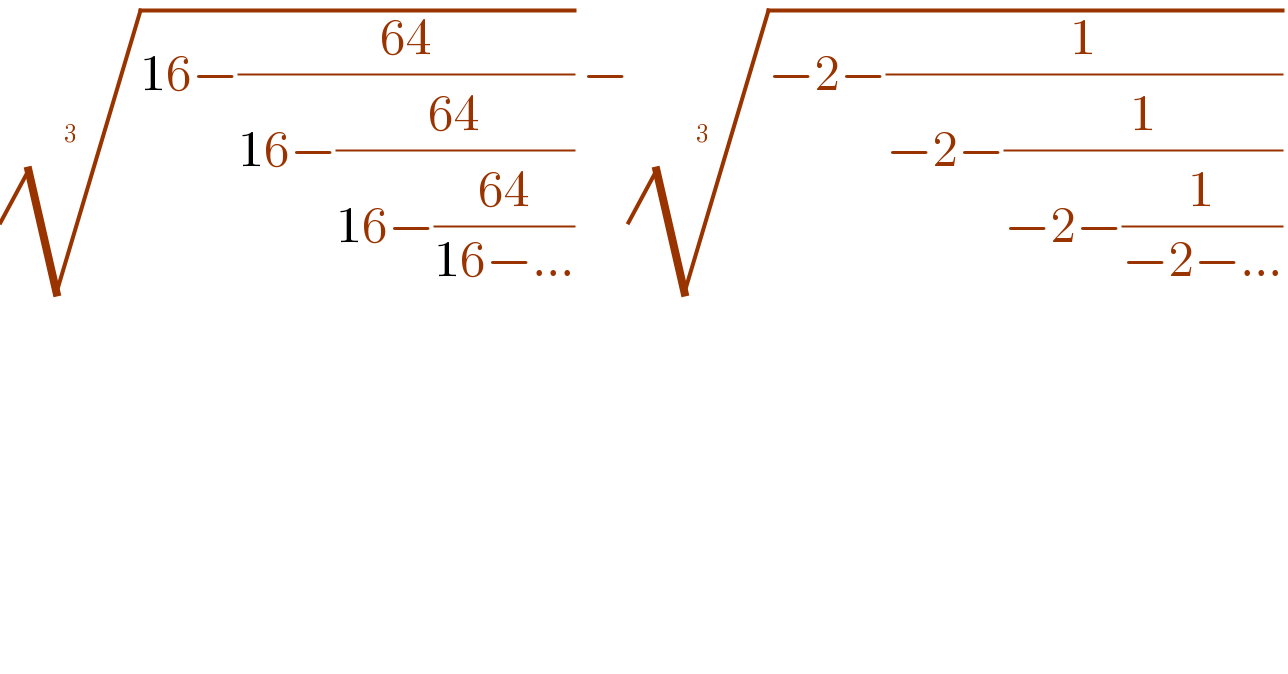
Question Number 100492 by bobhans last updated on 27/Jun/20

$$\sqrt[{\mathrm{3}\:\:\:}]{\mathrm{16}−\frac{\mathrm{64}}{\mathrm{16}−\frac{\mathrm{64}}{\mathrm{16}−\frac{\mathrm{64}}{\mathrm{16}−...}}}}−\sqrt[{\mathrm{3}\:\:}]{−\mathrm{2}−\frac{\mathrm{1}}{−\mathrm{2}−\frac{\mathrm{1}}{−\mathrm{2}−\frac{\mathrm{1}}{−\mathrm{2}−...}}}} \\ $$
Commented by Dwaipayan Shikari last updated on 27/Jun/20

$$\mathrm{p}=\mathrm{16}−\frac{\mathrm{64}}{\mathrm{16}−\frac{\mathrm{64}}{\mathrm{16}−\frac{\mathrm{64}}{.....}}} \\ $$$$\mathrm{p}=\mathrm{16}−\frac{\mathrm{64}}{\mathrm{p}}\Rightarrow\mathrm{p}^{\mathrm{2}} −\mathrm{16p}+\mathrm{64}=\mathrm{0}\Rightarrow\mathrm{p}=\mathrm{8} \\ $$$$\mathrm{y}=−\mathrm{2}−\frac{\mathrm{1}}{−\mathrm{2}−\frac{\mathrm{1}}{−\mathrm{2}−\frac{\mathrm{1}}{.....}}} \\ $$$$\mathrm{y}=−\mathrm{2}−\frac{\mathrm{1}}{\mathrm{y}}\Rightarrow\mathrm{y}^{\mathrm{2}} +\mathrm{2y}+\mathrm{1}=\mathrm{0}\Rightarrow\:\:\mathrm{y}=−\mathrm{1} \\ $$$$\sqrt[{\mathrm{3}}]{\mathrm{p}}−\sqrt[{\mathrm{3}}]{\mathrm{y}}=\mathrm{2}−\sqrt[{\mathrm{3}}]{−\mathrm{1}}\:\:\:\left(\mathrm{imaginary}\:\mathrm{value}\:\mathrm{for}\:\mathrm{second}\:\mathrm{sum}\right) \\ $$$$\mathrm{Or}\:\:\:\mathrm{2}−\left(−\mathrm{1}\right)=\mathrm{3} \\ $$$$\mathrm{But}\:\mathrm{it}\:\mathrm{also}\:\mathrm{takes}\:\mathrm{two}\:\mathrm{complex}\:\mathrm{roots} \\ $$
Commented by floor(10²Eta[1]) last updated on 27/Jun/20
![bro the imaginary value is (√(−1)) the^3 (√(−1)) it′s just −1 [(−1)^3 =−1] (and the other 2 complex roots)](Q100559.png)
$${bro}\:{the}\:{imaginary}\:{value}\:{is}\:\sqrt{−\mathrm{1}} \\ $$$${the}\:^{\mathrm{3}} \sqrt{−\mathrm{1}}\:{it}'{s}\:{just}\:−\mathrm{1}\:\left[\left(−\mathrm{1}\right)^{\mathrm{3}} =−\mathrm{1}\right] \\ $$$$\left({and}\:{the}\:{other}\:\mathrm{2}\:{complex}\:{roots}\right) \\ $$
Commented by Coronavirus last updated on 27/Jun/20
������
Answered by bramlex last updated on 27/Jun/20

$${let}\:{q}\:=\:\sqrt[{\mathrm{3}}]{\mathrm{16}−\frac{\mathrm{64}}{\mathrm{16}−\frac{\mathrm{64}}{\mathrm{16}−...}}} \\ $$$${q}^{\mathrm{3}} \:=\:\mathrm{16}−\frac{\mathrm{64}}{{q}}\:\Rightarrow\:{q}^{\mathrm{4}} −\mathrm{16}{q}+\mathrm{64}\:=\:\mathrm{0} \\ $$$${let}\:{r}\:=\:\sqrt[{\mathrm{3}\:}]{−\mathrm{2}−\frac{\mathrm{1}}{−\mathrm{2}−\frac{\mathrm{1}}{−\mathrm{2}−...}}} \\ $$$${r}^{\mathrm{3}} \:=\:−\mathrm{2}−\frac{\mathrm{1}}{{r}}\:\Rightarrow\:{r}^{\mathrm{4}} +\mathrm{2}{r}+\mathrm{1}=\mathrm{0}\:;\:{r}=−\mathrm{1} \\ $$$$ \\ $$
Answered by floor(10²Eta[1]) last updated on 27/Jun/20

$${let}\:{x}=\mathrm{16}−\frac{\mathrm{64}}{\mathrm{16}−\frac{\mathrm{64}}{\mathrm{16}−...}}\:\: \\ $$$${and}\:{y}=−\mathrm{2}−\frac{\mathrm{1}}{−\mathrm{2}−\frac{\mathrm{1}}{−\mathrm{2}−...}} \\ $$$${so}\:{we}\:{want}\:{to}\:{know}\:^{\mathrm{3}} \sqrt{{x}}−^{\mathrm{3}} \sqrt{{y}}. \\ $$$${x}=\mathrm{16}−\frac{\mathrm{64}}{{x}}\Rightarrow{x}^{\mathrm{2}} −\mathrm{16}{x}+\mathrm{64}=\mathrm{0}\Rightarrow{x}=\mathrm{8}\: \\ $$$${y}=−\mathrm{2}−\frac{\mathrm{1}}{{y}}\Rightarrow{y}^{\mathrm{2}} +\mathrm{2}{y}+\mathrm{1}=\mathrm{0}\Rightarrow{y}=−\mathrm{1} \\ $$$${so}\:^{\mathrm{3}} \sqrt{{x}}−^{\mathrm{3}} \sqrt{{y}}=^{\mathrm{3}} \sqrt{\mathrm{8}}−^{\mathrm{3}} \sqrt{−\mathrm{1}}=\mathrm{2}−\left(−\mathrm{1}\right)=\mathrm{3}. \\ $$
